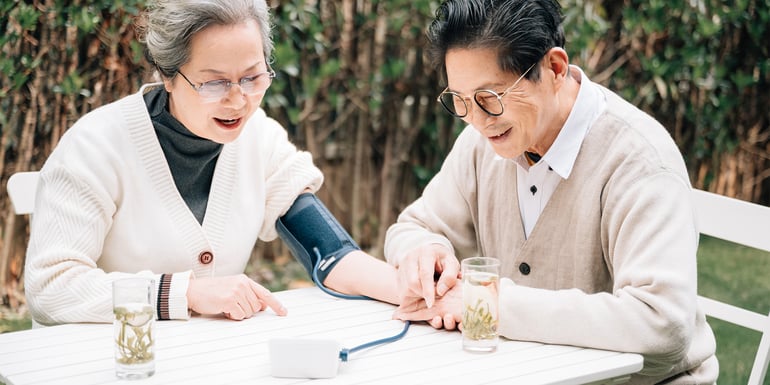
Stroke and heart attack are among the two most common fears families have as their loved ones get older, and for good reason. Stroke risk doubles every decade after the age of fifty-five, and they can have devastating, long-term effects.
The good news is some people fully recover from strokes. The bad news? Over two-thirds of stroke survivors are left with some type of disability.
How to Identify a Stroke
Most strokes are caused by blocked circulation. Therefore, heart health can play a key role in the prevention of a stroke. The best way to help prevent a stroke is to eat a healthy diet, exercise regularly, and avoid smoking and drinking too much alcohol. These lifestyle changes can reduce the risk of arteries becoming clogged, high blood pressure, and high cholesterol levels.
F.A.S.T is an easy acronym to help identify a stroke.
- F: face drooping — Ask the person to smile and look for drooping on one side of the face.
- A: arm weakness — Have the person raise both arms and look for one side to drift downward.
- S: speech difficulty — Slurred or difficult speech, have the person repeat a short sentence correctly.
- T: time to call 911 — Even if symptoms may resolve, early intervention is critical.
Time is of the essence in treating stroke. Patients treated within the first three hours of symptoms often have less disability three months after the stroke. The American Stroke Association offers a wide variety of resources for families, including educational materials on F.A.S.T. and their Let’s Talk About Stroke series.
Treatment of a Stroke
Stroke is a leading cause of serious long-term disability. Stroke reduces mobility in more than half of stroke survivors age 65 and older.
Caregiving can be triggered by a crisis, such as a fall or a stroke. Many families provide emotional support and assistance to their older parents, grandparents, and other family members when they can no longer function independently.
Preparing for an emergency, whether a medical crisis or severe weather, can give you peace of mind and improve any care your loved one receives. Waiting until a pending hospital discharge to identify how best to support your loved one can prevent your family from having a well thought out plan that provides your loved one the care they need and takes their wishes into consideration.
In some cases, your loved one might need temporary or long-term support after a stroke. Some people are natural-born caregivers, while others really struggle with taking up the mantle of caregiving. Your own health, family or career commitments can leave little room for you to take on caregiving responsibilities.
Sometimes the extensive support needed simply outweighs the benefits of trying to provide in-home support to a family member who has experienced a stroke. Communities like Highgate Senior Living can offer respite (a short-term stay) or long-term opportunities for caregiving support.
Another key reason many families consider long-term care support for a loved one who has suffered a stroke is to reduce the risk that a stroke may occur again. 1 in 4 stroke survivors will have another. Yet up to 80% of strokes may be prevented with a combination of medication and healthy habits, such as a healthy diet and physical activity, which can have a big impact.
Regardless of the long-term plan, you decide on for your loved one, additional support can help you cope with the lasting effects a major medical crisis, like a stroke, can have on your family. Support groups can provide an opportunity to share personal experiences, coping strategies, or firsthand information about diseases or treatments. Fortunately, Flagstaff offers a Stroke Support Group through Northern Arizona Healthcare that families can plug in to.






